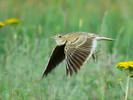search
classification
|
basic information
|
video
|
reports |
Calandra Lark
Melanocorypha calandra (Linnaeus, 1766)

|

|
|
|
2017-05-19
Djal, Chuy Valley |
© Ivan Turkovskiy
|
|
Description
The Calandra Lark is a large, Starling-sized, strongly built bird with short tail and strong bulbous bill. The coloration is typical on Larks; the upperparts are sandy-grey dark streaked and the underparts are off-white. On craw-sides there are two large black triangle-rounded patches sometimes connected on the craw. The breast is with dark streaks. The most obvious feature in flight is the dark wings with white terminal band, especially well appreciable on underwing. The tail is short and narrow because the bird usually folds tail even in the song-flight. Males and females are similar, but males are larger (wings lengths are not crossed). In autumn plumage the coloration is generally same but more buffy above because of fresh broad edges of feathers; dark patches on craw-sides are less on size and less obvious. Autumn juveniles are not distinguished from adults. Weight 53-73 grams, length 19-22, male wing 122-141, female wing - 115-122, wingspan 38-44 cm.
Biology
The Calandra Lark is common, in places numerous, breeding migrant. Inhabits feather-grass/wormwood, grass/wormwood, fescue/wormwood and wormwood steppe, dry and flooded meadows, wheat, lucerne and clover fields, fallow lands, both on plains and in foothills up to 1300-2000 m. During migration occurs on stubble fields, lake shores and tracks in flocks of up to thousand of birds. Appears early, from mid February to early March, most birds migrating in March. Breeds in separate pairs 100-200 m apart. Nest is built in a shallow scrape under grass shelter and made of dry grass. Clutches of 3-6 eggs found in mid April to mid of May. Females incubate, though males also have a brood patch. Both parents feed juveniles, who fledge when 10-11 days old, from mid May to June. Repeated breeding after loss of first nest is common. The last singing males recorded in early July. Autumn migration begins in August, when many birds concentrate near lakes, artesian wells and other water sources, often with other lark species. Most birds depart in the second half of September to mid of October. Last flocks recorded in early – end November. In the southern areas the Calandra Lark winters in the breeding range.
References
Gavrilov E. I., Gavrilov A. E. "The Birds of Kazakhstan". Almaty, 2005. В.К.Рябицев. "Птицы Урала, Приуралья и Западной Сибири". Екатеринбург, Изд-во Уральского университета, 2000. Э.И.Гаврилов. "Фауна и распространение птиц Казахстана". Алматы, 1999.









